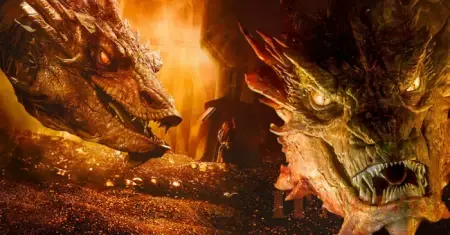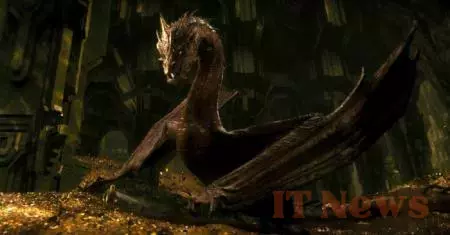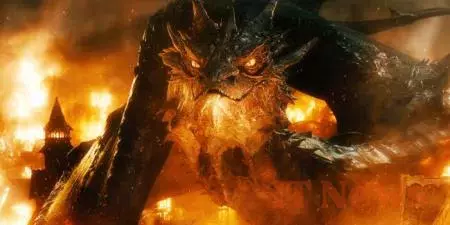We owe Smaug's success to the voice and motion capture of actor Benedict Cumberbatch, as well as the very successful work of the VFX studio teams at Weta Digital. But also to Peter Jackson, who came up with a brilliant idea to create the dragon's devastating fire.
The best scene from The Desolation of Smaug
Smaug is one of the very best elements of The Hobbit trilogy. Well helped by the voice from beyond the grave of Benedict Cumberbatch (Marvel's Doctor Strange) and the very beautiful work of Weta Digital studios - who brought the creature to life in CGI (his almost human facial expressions are disturbing) - the dragon is a real success. We all still remember the dialogue scene between him and Bilbo in the treasure room of Erebor, followed by a spectacular scene where, red with anger, he chases the Hobbit and the Dwarves into the foundry.
Peter Jackson knew how to bring real intensity to The Desolation of Smaug, the second part of the The Hobbit trilogy. Especially since not much is known about the saurian's history, except that attracted by the wealth of the Dwarves, it attacked the kingdom under the Lonely Mountain in 2770 in the Third Age, and resided there for 170 years. As for his origins... he probably comes from the Withered Moor, a region located in the far north of Middle-earth, where the majority of dragons of the time came from.
A huge flamethrower inspired Smaug's fire
There are a number of anecdotes about Smaug, such as Guillermo del Toro's initial version (the director of Pan's Labyrinth was to direct the trilogy), or the fact that he has several nicknames. Peter Jackson had a hard time faithfully representing the creature in keeping with the dragons of his species from the lore of Lord of the Rings, and in particular how to materialize its destructive weapon: fire.
To make the beast more powerful and menacing than ever, the New Zealand director drew his inspiration from a documentary retracing the horrors of the First World War. Seeing the English army use Livens' Great Flamethrower during the Battle of the Somme, he found his deux ex machina. This imposing flamethrower, 17 meters long, weighing 2.5 tons, was composed of a long chamber containing the fuel, a large pipe and a nozzle on the surface, capable of projecting flames up to 40 meters away. A deadly weapon that required no fewer than 300 people to assemble it, and eight to operate it.
Behind the scenes of In The Desolation of Smaug, Jackson called it a veritable "flamethrower from hell." The Weta Digital team then worked to achieve a similar rendering of the fire projected by the structure, that is, a flaming liquid jet, in order to create more physics and a sense of weight. The final rendering is highly commendable. Even when it's not spat out, and flows inside Smaug (the effects are also successful), the fire has its own small effect.
While Peter Jackson didn't specify anything on this subject, the intensity of the bombing and the desolate landscapes of the French countryside undoubtedly inspired him for the destruction of Lake-town/Esgaroth, ravaged by flames in The Battle of the Five Armies. By drawing inspiration from the ravages of the First World War, Peter Jackson pays homage to J.R.R. Tolkien, who also drew on the Great War to construct his story. He even lived through it. He joined the British Army at the age of 23, fought in the Battle of the Somme, and lost several of his friends. Bruised and suffering from a disease called trench fever, he was repatriated to his homeland.
It is therefore an understatement to say that conflict is at the heart of his work. The desolate landscapes of Mordor recall those of the trenches, the Marsh of the Dead echoes the muddy battlefields, shell-pocked and strewn with countless bodies, The Shire is this bucolic pre-war England, and the industrialization of Isengard by Saruman, its trees felled for construction, are a direct reference to the industrial war that weighs on the soldiers. The overwhelming power of Mordor on the heroes is symbolic of what the novelist experienced in the company of his friends.






0 Comments